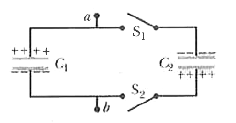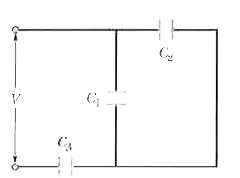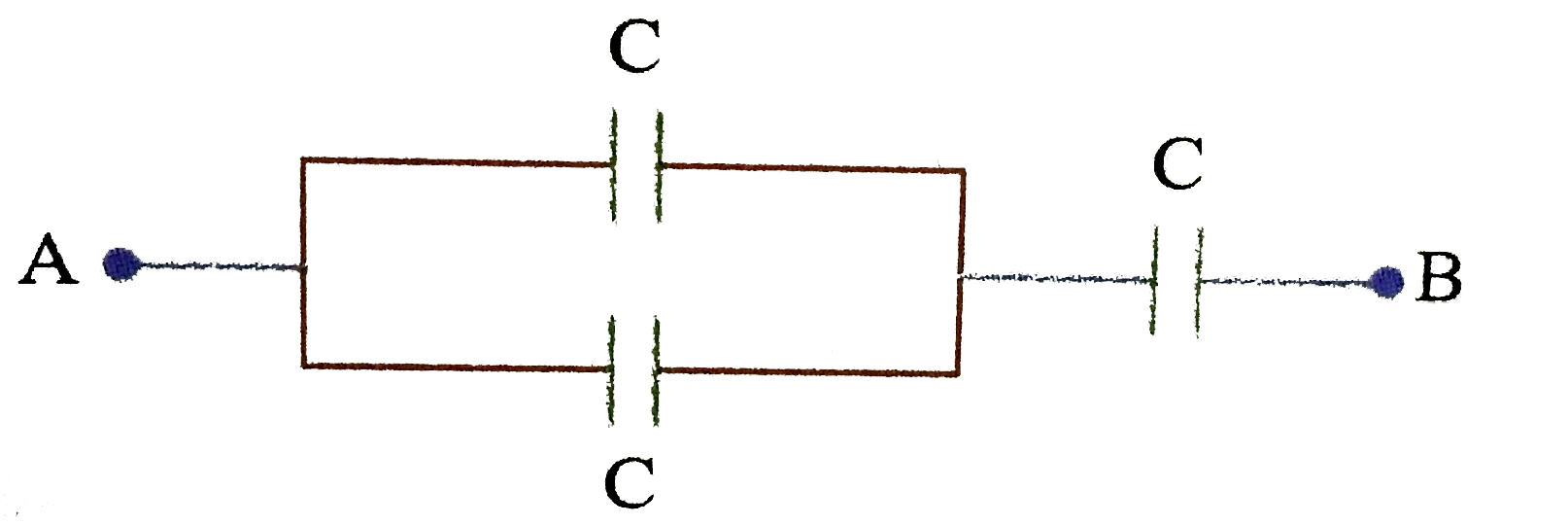In fig 25-31 C1=10.0μF,C2=20.0μFandC3=5.00μF If no capacitor can withstand a potential difference of more than 100V without failure , what are (a) the magnitude of the maximum potential difference that can exist between points A and B and (b) the maximum energy that can be stored in the three capacitor arrangement?

a)175Vb)4.375×10−2J≈44mJ
Topper's Solved these Questions
- BOOK - RESNICK AND HALLIDAYCHAPTER - CAPACITANCEEXERCISE - PRACTICE QUESTIONS (SINGLE CORRECT CHOICE TYPE)23videos
CAPACITANCE
- BOOK - RESNICK AND HALLIDAYCHAPTER - CAPACITANCEEXERCISE - PRACTICE QUESTIONS (MORE THAN ONE CORRECT CHOICE TYPE)12videos
CAPACITANCE
- BOOK - RESNICK AND HALLIDAYCHAPTER - CAPACITANCEEXERCISE - CHECKPOINTS4videos
CAPACITANCE
- BOOK - RESNICK AND HALLIDAYCHAPTER - ALL ABOUT ATOMS EXERCISE - CHECKPOINT1videos
ALL ABOUT ATOMS
- BOOK - RESNICK AND HALLIDAYCHAPTER - CENTER OF MASS EXERCISE - Practice Questions (Integer )4videos
CENTER OF MASS
Similar Questions
In fig 25-39 the capacitances are C1=1.0μFandC2=3.0μF and both capacitors are charged to a potential difference of V=200V but with opposite polarity as shown. Switches S1andS2 are now closed. (a) What is the now the potential difference between points a and b? What now is the charge on capacitor (b) 1 and (c) 2?
 View Solution
View SolutionA capacitor in an LC oscillator has a maximum potential difference of 17 V and a maximum energy of 160 μJ. When the capacitor has a potential difference of 5 V and an energy of 10 μJ, what are (a) the emf across the inductor and (b) the energy stored in the magnetic field?
View Solution
Knowledge Check
- Question 1 - Select One
In the circuit below C1=20μF , C2=40μ F and C3=50μ F . If no capacitor can sustain more than 50 V, then maximum potential difference between X and y is
 A95 VB75 VC150 VD65 v
A95 VB75 VC150 VD65 v - Question 2 - Select One or More
In the arrangement shown, a potential difference is applied between points A and B. No capacitor can withstand a potential difference of more than 100 V
 AThe magnitude of the maximum potential difference that can exist between points A and B is 300 VBThe maximum potential difference that can exist across C2 si 50 VCThe maximum charge that can be stored by C3 is 2 mCDThe maximum energy that can be stored in the three capacitor arrangement is 190 mJ
AThe magnitude of the maximum potential difference that can exist between points A and B is 300 VBThe maximum potential difference that can exist across C2 si 50 VCThe maximum charge that can be stored by C3 is 2 mCDThe maximum energy that can be stored in the three capacitor arrangement is 190 mJ - Question 3 - Select One
A capacitor in an LC oscillator has a maximum potential difference of 17V and a maximum energy of 160μJ.When the capacitor has a potential difference of 5V and an energy of 10μJ, what is the energy stored in the magnetic field?
A10μJB150μJC160μJD170μJ
In Fig. 25-25 C1=10.0μF,C2=5.0μFandC3=4.0μF What is the change in their equivalent capacitance if (a) capacitors 1 and 2 are interchanged and (separately) (B) capacitors 1 and 3 are interchanged?
 View Solution
View SolutionIn the net work three identical capacitors are connected as shown. Each of them can withstand to a maximum 100V potential difference. What is the maximum voltage that can be applied across A and B so that no capacitor gets spoiled.
 .View Solution
.View SolutionA 2.0μF capacitor and a 4.0μF, capacitor are connected in parallel across in 300V potential difference (a) What is the total energy stored by them? (b) They are next connected in series across that potential difference. What is the ratio of the total energy stored by them in the parallel arrangement to that in the series arrangement?
View SolutionA capacitor when charged by a potential difference of 200 Volts, stores a charge of 0.1C. By discharging energy liberated by the capacitor is-
View SolutionIn the given circuit , the potential difference between A and B is 18 V and charge on 2 μF capacitor is 24 μ C . The value of C is
 View Solution
View Solution

